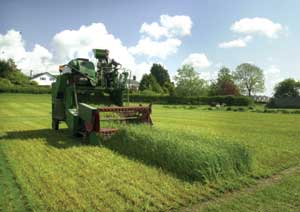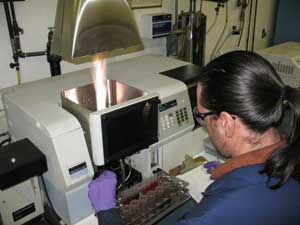July 2008
 View Full Print Edition
View Full Print EditionBusiness Briefs
Columns

In the Shoes of the Oil, Gas Industry
By Mike Bryan
Gap Between Corn, Cellulose Emerges
By Craig A. Johnson

Gas Pains
By Rona Johnson

Risk Factors: Protect the Company and the Investor
By Sara Thompson
Canola Biodiesel: Good for the Heart, Engine
By Angela Dansby
Featured

Minnesota's Innovative Ethanol Man
By Ron Kotrba / Photos By John Cross
Novel energy sources and coproduct streams abound at Corn Plus LLLP, an average-sized ethanol plant in southern Minnesota that functions in a far-from-average way. That's because the man at the helm, industry pioneer Keith Kor, is willing to take chances. This is his story.

Promoting Positive Perceptions
By Susanne Retka Schill
As the world grapples with the weighty issues of energy independence, climate change and food versus fuel, corn ethanol and palm oil's roles are often unfairly criticized or misunderstood. EPM takes a look at how palm oil and corn producers deal with negative publicity.

China to Host World Biofuels Symposium
By Craig A. Johnson
China's energy needs are expected to increase by nearly 50 percent in the next 12 years. Because much of this energy will be used by the country's burgeoning middle class to fuel its cars, keeping up with new demand for transportation fuel is going to be challenging.

National Forest Biomass Off-Limits for RFS
By Hope Deutscher
In national forests from Arizona to Montana, thousands of slash piles left by the timber industry could be used to produce cellulosic ethanol. Before that can happen, the language in the Energy Independence & Security Act must be changed.

What Comes First?
By Hope Deutscher
In the past five years ethanol plants have popped up across the countryside, but the vast number of employees required to run those plants has not materialized as quickly. That has led renewable energy companies, ethanol plants, technical colleges and universities to collaborate and provide the much-needed training of tomorrow's ethanol producers.

Sweet Harvest
By Timothy Charles Holmseth
Many years have passed since sweet sorghum made its debut in the 1800s as a possible substitute for sugarcane. The crop is now back by popular demand, this time as a potential ethanol feedstock.

Ethanol Takes to the Skies
By Rona Johnson
Ethanol is the fuel of choice for Greg Poe but rather than use it in his flexible-fuel vehicle he uses it to fuel up his high-performance aerobatic Fagen MX-2 airplane.

Workforce Future
By Tom Bryan and Craig A. Johnson / Photos By Craig A
Growth projections in the ethanol industry are being scaled back in response to the slowdown in new plant construction. As the current generation of ethanol companies mature, locating highly-skilled employees may be challenging.

Poetry in Motion
By Kris Bevill
With 23 plants in operation and three under construction there's no doubt Poet LLC has been growing constantly since it first began producing ethanol from corn 20 years ago. EPM takes a look back at the company's early years and explores its future.
Blame it on Price-Distorting Agriculture and Trade Policies
By Anduin Kirkbride McElroy
The latest controversy over food versus fuel started in February when two different studies theorized that demand for corn to make ethanol would not only increase food prices but also alter global land-use patterns and could have a devastating affect on climate change. But some researchers say the recent hike in food prices is the product of agriculture and trade policies that have caused global land-use patterns to shift over several decades.

Anaerobic Organisms Key to Coskata's Rapid Rise
By Jessica Sobolik
Not many people were familiar with Coskata Inc. when General Motors Corp. announced its partnership with the Chicago-based ethanol technology company in January. Since then, Coskata's business has accelerated at a rapid pace, making thermochemical ethanol production from biomass a near-term reality.

Cellulosic Ethanol Path is Paved With Various Technologies
By Jessica Ebert
In the midst of rising oil prices, the economics of producing cellulosic ethanol are becoming increasingly favorable and several companies are steadfastly moving to commercialize various process technologies. It would be easy to view this development as a race pitting one technology against the other but is that really the case? Is one approach better than another?

Grass: NOT JUST ANOTHER PLOT
By Susan Aldridge
We know cows like it—and by eating certain varieties, they give more milk. So do these grasses' higher sugar content also mean greater ethanol output?

Fresh-Squeezed Ethanol Feedstock
By Kris Bevill
Seventy-five percent of U.S. oranges are grown in Florida. The Sunshine State's citrus processing industry produces nearly all of the orange juice consumed in the country, resulting in up to 5 million tons of citrus waste each year. Options for turning that waste into something useful are limited, so the possibility of using citrus waste as a feedstock for ethanol plants is being closely monitored.

Pipeline Projects On Hold
By Elizabeth Ewing
Brazilian ethanol pipeline projects are budding, but not all will bloom.

Feeding it Back
By Diane Greer
The U.K.'s food industry is discovering the economic benefits of using combined-heat-and-power systems fueled by biomass or biogas. New technologies to convert wastes to renewable energy are gaining in popularity due to the high cost of energy and waste disposal, pressure to reduce carbon emissions and divert waste from landfills.
Anaerobic Organisms Key to Coskata's Rapid Rise
By Jessica Sobolik
Not many people were familiar with Coskata Inc. when General Motors Corp. announced its partnership with the Chicago-based ethanol technology company in January. Since then, Coskata's business has accelerated at a rapid pace, making thermochemical ethanol production from biomass a near-term reality.

Eyes on the North: Canada Ramps Up Bioenergy Activity
By Crystal Luxmore
Delivering a Sweet-Fueled Vehicle
By Jerry W. Kram

Breakthroughs in Green Gasoline Production
By Jessica Ebert
Biomass-derived fuels are garnering a lot of attention because they are chemically similar to petroleum-based fuels and can be used in existing engines and moved through the pipeline system.

Grass: It's Not Just for Grazing
By Susan Aldridge
We know cows like it-and by eating certain varieties, they give more milk. So do these grasses' higher sugar content also mean greater ethanol output?

Sizing-Up Anaerobic Digestion
By Bryan Sims / Photos By Jim Manganella
Environmental Power Corp. aims to become a premier player in the biomass industry by developing large-scale anaerobic digestion systems. Biomass Magazine talks with company officials about their thriving business model and how it could become the standard for others who want to convert waste into energy.

Pellet Properties
By Jerry W. Kram
Economists exhort consumers to gather as much information as possible before making a purchase. But for those buying fuel pellets for residential or industrial heat, basic information such as heat content, ash and chloride can be hard to obtain. The Pellet Fuels Institute is helping pellet manufacturers create testing programs to help consumers know what they are buying.

Is There Room For Camelina?
By Khalila Sawyer
With a short growing season and low harvesting costs, Camelina sativa could hold a small market in the western Canadian biofuels industry. Despite those advantages, limited research has been done to determine its full agronomic potential. While it's been touted as a potential feedstock for biodiesel, it remains an under-exploited crop, and with an industry entrenched in canola-based biodiesel, is there enough room to consider camelina?

Do Oil and Biodiesel Mix?
By Kris Bevill
Nova Biosource Fuels Inc. is headquartered in Houston-the heart of America's oil industry. The biodiesel company has several former oil executives and industry professionals on its payroll who think there's room enough in Texas for both fuels.
Rising in the East
By Khalila Sawyer
With a number of new developments in the biofuels sector, eastern Canada is making waves with new funding, projects, opportunities and hope. But, with a lack of provincial government support and biofuel initiatives, the renewable fuels industry in the Maritimes is struggling to catch up to the rest of the country. Nevertheless, eastern Canada continues working to establish its presence in the biofuel industry with a variety of resources and opportunities.

The Nature of Standards
By Jerry W. Kram
A significant effort has been made by the biodiesel industry to create quality standards and encourage producers to adhere to those standards. But why are standards necessary in the first place? What do they contribute to the industry that makes all the time, effort and negotiations worthwhile?

Palm Oil Fights Back
By Susanne Retka Schill
Malaysian oil palm growers try to turn the tide of public criticism with a conference devoted to discussing the tropical oil crop's sustainability and carbon footprint.

Micromanaging Fuel Use
By Ron Kotrba
Rising fuel prices and the need to conserve resources and protect the environment make excellent motivators for fleet operators to reconsider how they refuel.
Contributions
A Multi-Prong Approach to Carbon Neutrality
By Stephen Paley

Case Study: Sound Water Management Reduces the Environmental Footprint of Two Ethanol Plants
By Tony Stanich and Jason Van't Hul
Plant-Wide Optimization of Sterling Ethanol LLC
By Srinivas Budaraju, Maina Macharia and Dave Kramer
Debunking the Myths of the Food-vs.-Fuel Debate
By Kenneth C. Reed

Overcoming Ethanol's Growing Pains
By Rick Kment

Playing It Safe: Areas of Focus for Safety Compliance
By Darren Small
Under Pressure Underground: Gravity Pressure Vessels Convert Waste into Biofuels
By Peter Hurrell and Zbigniew "Zig" Resiak

Ethanol Production Monitoring Using Ion Exclusion HPLC
By Michael McGinley and Jim Mott
Improving Business Operating Consistency, Performance
By Scott McDermott

Beating the Environmental Enforcement Squeeze
By Timothy A. Wilkins
Assessing the Impact of Mexico's Biofuels Law
By Raul Felix
Under Pressure Underground: Gravity Pressure Vessels Convert Waste into Biofuels
By Peter Hurrell and Zbigniew "Zig" Resiak





















